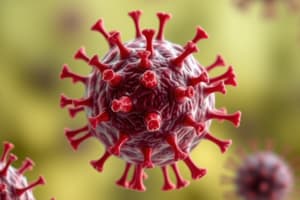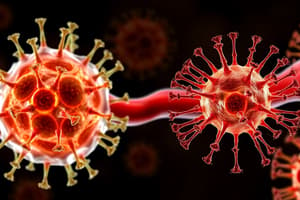Podcast
Questions and Answers
A deficiency in which complement protein specifically increases susceptibility to Neisseria bacterial species?
A deficiency in which complement protein specifically increases susceptibility to Neisseria bacterial species?
- Factor I
- Factor D
- C3
- C5-C9 (correct)
Which of the following is NOT an effect of the complement pathway?
Which of the following is NOT an effect of the complement pathway?
- Chemotaxis of immune cells
- Direct lysis of microbes
- Opsonization of pathogens
- Inhibition of inflammatory responses (correct)
Which complement protein initiates the membrane attack complex (MAC)?
Which complement protein initiates the membrane attack complex (MAC)?
- C3a
- Factor B
- C3b
- C5b (correct)
What are the primary molecules that act as anaphylatoxins in the complement pathway?
What are the primary molecules that act as anaphylatoxins in the complement pathway?
How is soluble C3b formed in the complement alternative pathway?
How is soluble C3b formed in the complement alternative pathway?
Which factor cleaves Factor B to create the active convertase (iC3Bb)?
Which factor cleaves Factor B to create the active convertase (iC3Bb)?
What is the effect of C3a and C5a on mast cells and basophils?
What is the effect of C3a and C5a on mast cells and basophils?
A deficiency in which of the following complement factors leads to increased susceptibility to both encapsulated bacteria and Neisseria species?
A deficiency in which of the following complement factors leads to increased susceptibility to both encapsulated bacteria and Neisseria species?
Which of the following best describes the primary role of CXCL8 in neutrophil recruitment?
Which of the following best describes the primary role of CXCL8 in neutrophil recruitment?
What is the function of integrins in the context of immune cell adhesion to endothelial cells?
What is the function of integrins in the context of immune cell adhesion to endothelial cells?
Which of these events happen first in oxygen dependent microbial killing within the phagosome?
Which of these events happen first in oxygen dependent microbial killing within the phagosome?
What is the role of secretory and ficolin-1 granules in neutrophil function?
What is the role of secretory and ficolin-1 granules in neutrophil function?
Which of these statements is true about band neutrophils?
Which of these statements is true about band neutrophils?
What is the primary function of gelatinase within neutrophil granules?
What is the primary function of gelatinase within neutrophil granules?
What function does the enzyme Arginase carry out during neutrophil extravasation?
What function does the enzyme Arginase carry out during neutrophil extravasation?
Which of the following is NOT directly involved in the early stages of cell arrest/rolling adhesion?
Which of the following is NOT directly involved in the early stages of cell arrest/rolling adhesion?
Which of the following is the primary function of iC3Bb?
Which of the following is the primary function of iC3Bb?
Which of the following best describes the role of Factor H in complement regulation?
Which of the following best describes the role of Factor H in complement regulation?
A deficiency in Factor I would most likely result in:
A deficiency in Factor I would most likely result in:
How does DAF contribute to the regulation of the complement system?
How does DAF contribute to the regulation of the complement system?
Which component directly stabilizes the C3bBb complex, enhancing complement activation?
Which component directly stabilizes the C3bBb complex, enhancing complement activation?
What is the correct order of the following steps involving the alternative C3 convertase?
What is the correct order of the following steps involving the alternative C3 convertase?
What is the primary role of the C3bbBb complex?
What is the primary role of the C3bbBb complex?
In the context of complement activation, what is the significance of sialic acid?
In the context of complement activation, what is the significance of sialic acid?
What occurs during positive selection of thymocytes?
What occurs during positive selection of thymocytes?
What is the outcome for T cells that recognize self-antigens strongly?
What is the outcome for T cells that recognize self-antigens strongly?
What role does costimulation play in T cell activation?
What role does costimulation play in T cell activation?
Which of the following describes signal 3 in T cell activation?
Which of the following describes signal 3 in T cell activation?
Which cells express both MHC I and MHC II for the purpose of negative selection?
Which cells express both MHC I and MHC II for the purpose of negative selection?
What triggers the signaling cascade following TCR binding?
What triggers the signaling cascade following TCR binding?
What is a characteristic of gamma delta T cells in relation to selection processes?
What is a characteristic of gamma delta T cells in relation to selection processes?
What initiates the signal required for TCR activation?
What initiates the signal required for TCR activation?
What distinguishes junctional diversity in the context of antibody formation?
What distinguishes junctional diversity in the context of antibody formation?
Which statement accurately describes combinatorial diversity in the formation of antibodies?
Which statement accurately describes combinatorial diversity in the formation of antibodies?
What role does RAG1/RAG2 play during the recombination process?
What role does RAG1/RAG2 play during the recombination process?
Which process specifically affects the CDR3 region in antibody formation?
Which process specifically affects the CDR3 region in antibody formation?
In which mechanism do TdT and DNA polymerase interact during antibody gene recombination?
In which mechanism do TdT and DNA polymerase interact during antibody gene recombination?
What is the primary outcome of somatic hypermutation following antigen exposure?
What is the primary outcome of somatic hypermutation following antigen exposure?
What is the main distinction between combinatorial association and combinatorial diversity?
What is the main distinction between combinatorial association and combinatorial diversity?
Which of the following is true regarding the limitation of T cells in terms of combining chains?
Which of the following is true regarding the limitation of T cells in terms of combining chains?
What is the main function of lactoferrin in the immune system?
What is the main function of lactoferrin in the immune system?
What is the primary role of azurophilic granules in neutrophils?
What is the primary role of azurophilic granules in neutrophils?
Which of the following cytokines is directly involved in activating NK cells?
Which of the following cytokines is directly involved in activating NK cells?
What is the primary mechanism by which NK cells recognize and kill target cells?
What is the primary mechanism by which NK cells recognize and kill target cells?
Which of the following describes a condition where the neutrophil count is less than 70% of the total white blood cell count?
Which of the following describes a condition where the neutrophil count is less than 70% of the total white blood cell count?
What is the primary function of mast cells in the immune response?
What is the primary function of mast cells in the immune response?
What is the main difference between the activation of mast cells by PRRs and by IgE?
What is the main difference between the activation of mast cells by PRRs and by IgE?
During an acute bacterial infection, what would you expect to see in the blood?
During an acute bacterial infection, what would you expect to see in the blood?
Flashcards
What is iC3Bb?
What is iC3Bb?
iC3Bb is a key enzyme in the alternative complement pathway. It cleaves C3, a crucial protein in the immune system, into C3b and C3a.
What does C3b do?
What does C3b do?
C3b is an important protein fragment generated from C3 cleavage by iC3Bb. It binds to the pathogen surface and plays a crucial role in targeting them for destruction.
What does C3a do?
What does C3a do?
C3a is a small protein fragment released when C3 is cleaved. It acts as an anaphylatoxin, attracting immune cells to the site of infection.
What is CR1?
What is CR1?
Signup and view all the flashcards
What does Factor I do?
What does Factor I do?
Signup and view all the flashcards
What does Factor H do?
What does Factor H do?
Signup and view all the flashcards
What is the alternative complement pathway?
What is the alternative complement pathway?
Signup and view all the flashcards
What is C3bBb?
What is C3bBb?
Signup and view all the flashcards
C3 Deficiency
C3 Deficiency
Signup and view all the flashcards
C5-C9 Deficiency
C5-C9 Deficiency
Signup and view all the flashcards
Factor D or Properdin Deficiency
Factor D or Properdin Deficiency
Signup and view all the flashcards
Membrane Attack Complex (MAC)
Membrane Attack Complex (MAC)
Signup and view all the flashcards
C3a and C5a
C3a and C5a
Signup and view all the flashcards
Anaphylactic Shock
Anaphylactic Shock
Signup and view all the flashcards
Alternative Pathway
Alternative Pathway
Signup and view all the flashcards
C3b
C3b
Signup and view all the flashcards
Combinatorial diversity
Combinatorial diversity
Signup and view all the flashcards
Combinatorial association
Combinatorial association
Signup and view all the flashcards
Junctional diversity
Junctional diversity
Signup and view all the flashcards
P nucleotide addition
P nucleotide addition
Signup and view all the flashcards
Exonuclease activity
Exonuclease activity
Signup and view all the flashcards
N nucleotide addition
N nucleotide addition
Signup and view all the flashcards
Somatic hypermutation
Somatic hypermutation
Signup and view all the flashcards
12/23 rule
12/23 rule
Signup and view all the flashcards
What is the role of lactoferrin?
What is the role of lactoferrin?
Signup and view all the flashcards
What is the function of azurophilic granules?
What is the function of azurophilic granules?
Signup and view all the flashcards
What is the role of NK cells in the immune system?
What is the role of NK cells in the immune system?
Signup and view all the flashcards
How does IL-12 contribute to the immune response?
How does IL-12 contribute to the immune response?
Signup and view all the flashcards
Describe the role of neutrophils in the immune system?
Describe the role of neutrophils in the immune system?
Signup and view all the flashcards
What does neutrophilia indicate?
What does neutrophilia indicate?
Signup and view all the flashcards
What does neutropenia indicate?
What does neutropenia indicate?
Signup and view all the flashcards
What is the role of mast cells in the immune response?
What is the role of mast cells in the immune response?
Signup and view all the flashcards
Double Positive (DP) T Cells
Double Positive (DP) T Cells
Signup and view all the flashcards
Positive Selection
Positive Selection
Signup and view all the flashcards
Negative Selection
Negative Selection
Signup and view all the flashcards
gamma delta T Cells
gamma delta T Cells
Signup and view all the flashcards
mTECs
mTECs
Signup and view all the flashcards
Signal 1 (T Cell Activation)
Signal 1 (T Cell Activation)
Signup and view all the flashcards
Signal 2 (T Cell Activation)
Signal 2 (T Cell Activation)
Signup and view all the flashcards
Signal 3 (T Cell Activation)
Signal 3 (T Cell Activation)
Signup and view all the flashcards
What is the role of CXCL8 in neutrophil recruitment?
What is the role of CXCL8 in neutrophil recruitment?
Signup and view all the flashcards
How do integrins contribute to neutrophil arrest and adhesion?
How do integrins contribute to neutrophil arrest and adhesion?
Signup and view all the flashcards
What is the role of selectins in immune cell rolling?
What is the role of selectins in immune cell rolling?
Signup and view all the flashcards
Summarize the steps of neutrophil recruitment.
Summarize the steps of neutrophil recruitment.
Signup and view all the flashcards
Explain the different types of neutrophil granules and their functions.
Explain the different types of neutrophil granules and their functions.
Signup and view all the flashcards
Describe the process of pathogen killing inside the phagosome.
Describe the process of pathogen killing inside the phagosome.
Signup and view all the flashcards
What is the role of phagolysosome fusion in pathogen killing?
What is the role of phagolysosome fusion in pathogen killing?
Signup and view all the flashcards
What are band neutrophils and why are they considered immature?
What are band neutrophils and why are they considered immature?
Signup and view all the flashcards
Study Notes
Innate vs Adaptive Immunity
- Innate immunity is non-specific, present from birth
- Innate immunity is always on, looking for non-self pathogens
- Innate immunity has no memory
- Innate immunity is as effective the first time as subsequent infections
- Innate immunity kicks starts inflammation
- Adaptive immunity is specific
- Adaptive immunity is activated by lymphocytes
- Adaptive immunity improves with each encounter and has memory antibodies
- Adaptive immunity has 3 types
- Innate and adaptive immunity do not act in isolation
- Complement activates B cells
- Phagocytes activate and differentiate B and T cells
- Antibodies act as opsonins for phagocytes
Distinguish Between Innate and Adaptive Immunity
- Innate immunity:
- Non-specific
- Present from birth
- Always on, looking for non-self pathogens
- Has no memory
- Effective the first time and subsequent infections
- Initiates inflammation
- Adaptive immunity:
- Specific
- Activated by lymphocytes
- Improves with each encounter
- Has memory antibodies
- 3 types
Studying That Suits You
Use AI to generate personalized quizzes and flashcards to suit your learning preferences.




